AP Calculus AB Ultimate Guide
Unit 1 - Limits and Continuity
A limit is the intended height of a graph, as x gets very close to a value. This means that when we follow a function, the limit will show what the height that the point is supposed to be, even if it doesn’t concur with the actual function
\lim_{x\to n}f\left(x\right)
Take this limit for example →\lim_{x\to2}\frac{x^2+5x+6}{x+2}
We can find this limit by plugging in x to the function → 4 + 10 + 6 / 4 → 5
Solving Limits
When you substitute the number and get \frac00, there are a few different ways you can solve it.
Factoring and eliminating the hole →\lim_{x\to2}\frac{t^2-3t+2}{t^2-4}=\frac00
The first option is factor the function so that we can eliminate the hole → \lim_{t\to2}\frac{\left(t-2\right)\left(t-1\right)}{\left(t+2\right)\left(t-2\right)}
Then, once you eliminate the hole, plug the value in again→\lim_{t\to2}\frac{t-1}{t+2}=\frac{2-1}{2+2}=\frac14
Making 1 fraction → \lim_{x\to0}\frac{\frac{1}{2+x}-\frac12}{x}=\frac00
First, to get the numerator sorted out, we need to find a common denominator for the two fractions in the numerator →\frac{1}{\left(2+x\right)}-\frac12\Rightarrow\frac{2}{2\left(2+x\right)}-\frac{2\left(2+x\right)}{2\left(2+x\right)}\Rightarrow\frac{2-2-x}{2\left(2+x\right)}\Rightarrow-\frac{x}{2\left(2+x\right)}
Now, we can simplify the fraction to get one fraction → -\frac{x}{2\left(2+x\right)}\cdot\frac{1}{x}\Rightarrow-\frac{1}{2\left(2+x\right)}\Rightarrow\lim_{x\to0}-\frac{1}{2\left(2+0\right)}=-\frac14
Multiplying by conjugate →\lim_{x\to0}\frac{x}{\sqrt{16+x}-4}=\frac00
In this situation, it would be best to try multiplying by the conjugate →\frac{x\left(\sqrt{16+x}+4\right)}{\left(\sqrt{16+x}-4\right)\left(\sqrt{16+x}+4\right)}
When we multiply everything out, we know that we only have to do the front terms and the back terms so we get →\frac{x\left(\sqrt{16+x}+4\right)}{16+x-16}=\frac{x\left(\sqrt{16+x}+4\right)}{x}=\sqrt{16+x}+4=\sqrt{16+0}+4=8
Here are some rules for limits as well! You can use these to help assist you in solving limits:
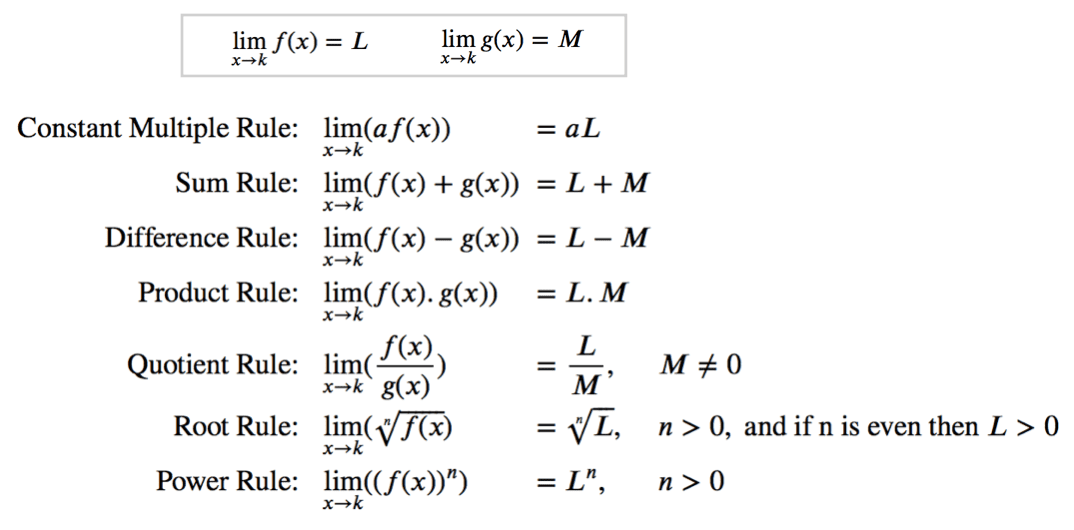
It is also helpful to remember → \lim_{x\to0}\frac{\sin x}{x}=1
x can be any number or symbol, but when it is the same on the bottom and top, it is equal to 1
I’ve also seen this limit rule →\lim_{x\to0}\frac{1-\cos x}{x}=0
Finding Limits Graphically / Numerically
Another way to find limits is by looking at a graph.
For a limit to exist, the function must approach the same height value from both sides
In this example, the limit does exist even though there is a hole because the function approaches the same height from both sides
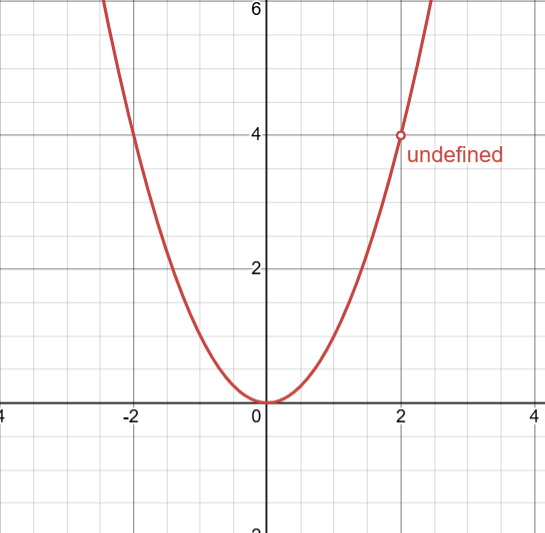
When the function approaches two different heights, the function might have an actual value, but the limit does not exist (mean girls reference!)
Here is an example, where the f(2) = 4, but the limit DNE
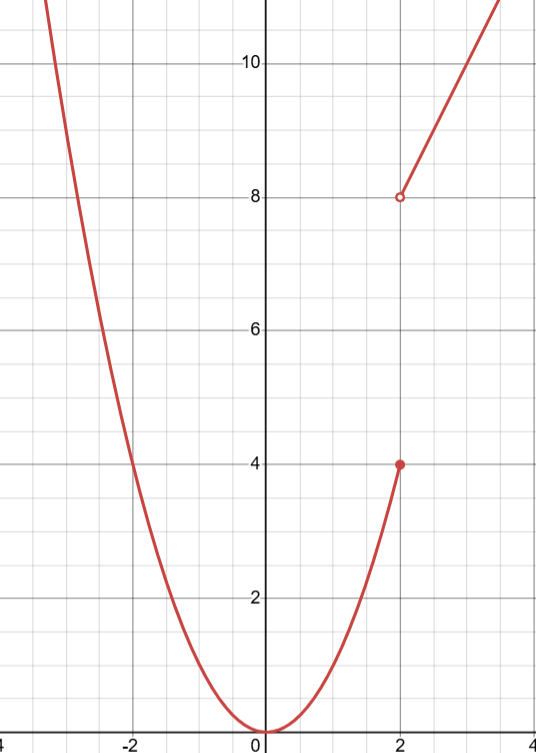
Limits approaching from the left side will have a - sign above the number (like 2-) and limits approaching from the right has a + sign above the number (like 2+)
We can also find limits from the table
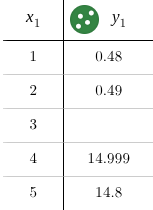
Don’t pay attention to the number it is approaching, as both sides may be approaching something different. In this example we can see that → \lim_{x\to3^{-}}y_1=5 and \lim_{x\to3^{+}}y_1=15
Because both limits approach something different, the limit does not exist → \lim_{x\to3}y_1=DNE
Squeeze Theorem
if g(x) <= f(x) <= h(x), while x does not equal c, in some interval about c, and \lim_{x\to c}g\left(x\right)=\lim_{x\to c}h\left(x\right)=L , then \lim_{x\to c}f\left(x\right)=L
Basically, the function f(x) is in between two functions (g(x) <= f(x) <= h(x)). By taking the limit of each function, and solving it, we can get the value of f(x).
When g(x) and h(x) are different, the limit of f(x) cannot be determined
Vertical Asymptotes
A vertical asymptote is defined as → the line x = a is a vertical asymptote of the graph of a function f(x) if either \lim_{x\to a^{\pm}}f\left(x\right)=\pm\infty
If you get confused with HA, remember that vertical asymptote limits will be approaching a NUMBER and result in ±infinity
You can find them by looking at a graph or looking at a table. The table will have values that get really big (in either pos or neg direction) really fast
You can find them without a calculator however
When direct substitution gives you \frac{n}{0}, you know it’s a vertical asymptote
The only possible one-sided limits are +∞ or -∞
Pick a value just to the left or right of your x on the side you are approaching from, and consider whether your height is positive or negative. This will give you the sign of the limit
Example →\lim_{x\to2^{-}}\frac{x^2+9}{x-2}\Rightarrow\lim_{x\to1.99}\frac{\left(1.99\right)^2+9}{1.99-2}\Rightarrow\frac{+}{-}\Rightarrow\lim_{x\to2^{-}}f\left(x\right)=-\infty
Horizontal Asymptotes
A horizontal asymptote is defined as → the line y = b is a horizontal asymptote of a function f(x) if either \lim_{x\to\pm\infty}f\left(x\right)=b
If you get confused with VA, remember that hortizontal asymptote limits will be approaching infinity and give 0/NA/#
It is also helpful to remember BOBO BOTNA EATSDC *remember from precalc?* (Bigger On Bottom = 0; Bigger On Top = No Asymptote; Exponents Are The Same = Divide Coefficients)
You can also find these by looking at a graph, but with horizontal asymptotes it takes some mental imagining (example function → f\left(x\right)=\frac{3x^2+2x-1}{5x^3+4x^2-x-2}
First, find the end behavior for the function, so just cancel out anything that isn’t the highest degree →EB=\frac{3x^2}{5x^3}=\frac{3}{5x}
Next, we need to think about both limits, so taking the limit of the end behavior as x approaches ± ∞.
If the denominator grows faster than the numerator, it gets smaller and smaller towards 0
If the numerator grows faster than the denominator, then the function will grow towards ± ∞, and therefore no HA
If the exponents are the same, then the limits will both approach the divided coefficients
In our case, 3/5x, the 5x will continue to grow further, while the numerator stays the same, meaning that the fraction will get closer and closer to 0
Continuity
Here are the types of discontinuity in graph form →

Removable
\lim_{x\to a^{-}}=\lim_{x\to a^{+}}\ne f\left(a\right)
The limits approaching the left or the right are equal, but the actual value is not
Jump
\lim_{x\to a^{+}}\ne\lim_{x\to a^{-}}
Here, the limits do not match, the function value may be the same as one of the limits, however
Infinite
\lim_{x\to a}=\text{DNE and/or }\lim_{x\to a^{+}}\ne\lim_{x\to a^{-}}
Here, the actual value does not exist and the limits approach infinity
Expanding the function to be continuous
When a function has a removable discontinuity, it is sometimes possible to extend the function. To do this, find the discontinuity and simply add the term to the existing piece wise function
Making functions continuous
Since a continuous function is \lim_{x\to c}f\left(x\right)=f\left(c\right) , we can use this in the following problem\begin{cases} x+2,x\ne4\\ k^{2}-2, x=4 \end{cases}
x=4 would be the actual value, and the other one would be the limit as x approaches 4. This means we just have to set them equal to each other and set x=4, meaning that we end up with 6 = k² - 2 →k = 2
Intermediate Value Theorem (IVT)
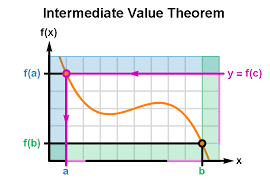
The IVT explains if a function is continuous between a and b, then it will pass through every value between f(a) and f(b)
for example, if we have the points (1, -1) and (2, 5) and we want to know about any real solutions where f(x) = x3 - x - 1. Here is how to justify →
check for continuity → f(x) is continuous, so IVT applies
sandwich your values → f(1) = -1 < 0 < 5 = f(2)
Answer (yes/no) by IVT → There is a real solution by IVT
Unit 2 - Differentiation: Definition and Fundamental Properties
Remember our average rate of change formula →\frac{f\left(a\right)-f\left(b\right)}{a-b}
But… what if we want to find the slope at one point? Finding that using our formula would lead to a number over zero
let’s say we have a function x². If we want the slope at point x=2, we take another point, for example (3, 9), and move that point closer and closer to x=2 until it gets infinitely close, and take the slope of that
That gives us the definition of a derivative
The definition of a derivative is this →f^{\prime}\left(x\right)=\lim_{h\to0}\frac{f\left(x+h\right)-f\left(x\right)}{h}
Basically it is \frac{rise}{run}=\frac{y_2-y_1}{x_2-x_1}=\frac{f\left(a\right)-f\left(b\right)}{a-b}=\frac{f\left(x+h\right)-f\left(x\right)}{x+h-x} , except we want to find the instantaneous rate of change (the rate of change of a single point). By differentiating a function, we get the derivative which is the rate of change at each point on a function
For example, find \frac{d}{dx}x^2=\lim_{h\to0}\frac{\left(x+h\right)^2-\left(x\right)^2}{h}
f^{\prime}\left(x\right)=\lim_{h\to0}\frac{x^2+2xh+h^2-x^2}{h} , now time to cancel terms!
\lim_{h\to0}\frac{2xh+h^2}{h}\Rightarrow\lim_{h\to0}\frac{h\left(2x+h\right)}{h}\Rightarrow\lim_{h\to0}2x+0\Rightarrow\frac{d}{dx}f\left(x\right)=2x
This fits within the power rule! Because →\frac{d}{dx}x^2=nx^{n-1}=2x^{2-1}=2x
Higher Order Notation
Let’s say we have the function f(x) = cos(x).
Finding the derivative of the derivative would be called the second derivative and would be written as so →\frac{d^2y}{dx^2},f^{\prime\prime}\left(x\right)=\frac{d}{dx}\left(\frac{d}{dx}\cos x\right)=\frac{d}{dx}-\sin x=-\cos x
Higher order derivative is noted by adding more primes or by this notation → \frac{d^{n}y}{dx^{n}}
Alternative Definition of Derivative
You might also see the derivative written these ways
f^{\prime}\left(a\right)=\lim_{h\to0}\frac{f\left(a+h\right)-f\left(a\right)}{h}\\ f^{\prime}\left(a\right)=\lim_{x\to a}\frac{f\left(x\right)-f\left(a\right)}{x-a}\\ f^{\prime}\left(a\right)=\lim_{h\to0}\frac{f\left(a+h\right)-f\left(a-h\right)}{2h}
In these cases, a is a plugged in value. You won’t have to manually solve these limits, but there is 3 things you should do
1 - find/spot the original function
2 - find the derivative of that function
3 - plug in any points (a) if you have to
Derivative Rules
Here are some more derivative rules:
Constant Rule → \frac{d}{dx}c=0
Coefficients → \frac{d}{dx}af\left(x\right)=a\cdot f^{\prime}\left(x\right)
Addition/Subtraction →\frac{d}{dx}\left(f\pm g\right)=f^{\prime}\pm g^{\prime}
Power Rule → \frac{d}{dx}\left(x^{n}\right)=nx^{n-1}
Product Rule → \frac{d}{dx}\left(f\cdot g\right)=fg^{\prime}+gf^{\prime}
You can remember this rule by simply remembering that it’s just multiplying by each others derivatives
If there is three or more terms, you do it like so → \frac{d}{dx}\left(fgh\right)=f^{\prime}gh+fg^{\prime}h+fgh^{\prime}
Quotient Rule → \frac{d}{dx}\left(\frac{f}{g}\right)=\frac{\left(g\cdot f^{\prime}\right)-\left(f\cdot g^{\prime}\right)}{g^2}
A way to remember this rule is that double ds come first (denominator x derivative) and then you switch (numerator x derivative). And then you just have to bring the denominator over and square it!
Another way to remember this is “low d high - high d low over low squared”
You also sometimes might be able to work out problems without the quotient rule like so →\frac{d}{dx}\left\lbrack\frac{x^3-4x+8}{x}\right\rbrack=\frac{x^3}{x}-\frac{4x}{x}+\frac{8}{x}=x^2-4+8x^{-1}=2x-8x^{-2}
Tangent & Normal Lines
A tangent line is the line at that point tangent to the function. To find the tangent line, you will need to use point slope formula (y2 - y1 = m(x2 - x1)), but instead of m, we plug in the slope from the derivative
For example, find the tangent line at point x=2 for the function f(x) = 2x²
First, we need to plug in the point to the original function f(2) = 8
Then, find the derivative of f →f’(x) = 4x
Then, we need to plug in 2 in the derivative → f’(2) = 8
Then using these values, we get the tangent line equation →y-8=8\left(x-2\right)
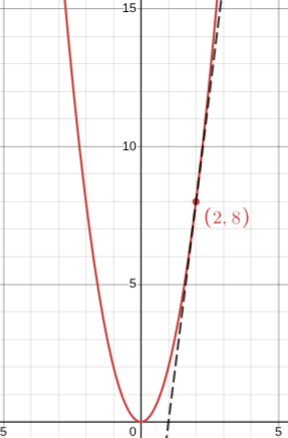
The slope for a normal line is just perpendicular, so the normal line equation would be → y - 8 = (-1/8)(x-2)
Linear Approximation
linear approximation is using a tangent line to approximate a value
Example, we want the value of x = 8.1 when y = √x
First, we write a tangent line close to the point, at x = 8
y^{\prime}\left(8\right)=\frac12x^{-\frac12}=\frac{1}{2\sqrt{x}}=\frac{1}{2\sqrt8}
Now that we have slope, the y-coordinate of the point would be √8, so our tangent line would be →y-\sqrt8=\frac{1}{2\sqrt8}\left(x-8\right)
Using this tangent line, we can plug in the real value of x, 8.1, and get out our y-value →y-\sqrt8=\frac{1}{2\sqrt8}\left(8.1-8\right)\Rightarrow\frac{1}{2\sqrt8}\left(0.1\right)+\sqrt8\Rightarrow2.846
That is very close to the actual value y(8.1)!
Points Parallel to Lines
At what point on the graph y = 3x + 1 is the tangent line parallel to the line y = 5x -1
We already know what slope we should be looking for and that is 5, because it is parallel, so we need to set the derivative equal to the slope → 3^{x}\ln3=5
Now, we need to solve for the x-value → 3^{x}=\frac{5}{\ln3}\Rightarrow\log_3\frac{5}{\ln3}=x
Now that we have our x-value, we can solve for the y value, by simply plugging that x-value back into our undifferentiated function → 3^{\log_3\frac{5}{\ln3}}+1=y_1
That gives us our messy looking point \left(\log_3\frac{5}{\ln3},3^{\log_3\frac{5}{\ln3}}+1\right)
Differentiability
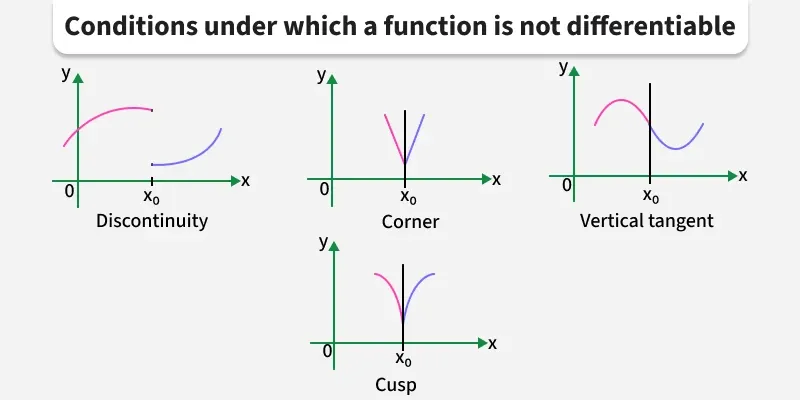
In order to be differentiable, a function must have equal one-sided derivatives and be continuous where the rule for the function changes
This means that → DIFFERENTIABILITY implies CONTINUITY
if f’(a) exists, then f(a) is continuous
However, the inverse is not true… just because something is continuous doesn’t imply differentiability
How to check if a piecewise function is differentiable
Given this piecewise function: f(x)=\begin{cases}3x^2,x\le1\\ 3x,x>1\end{cases}
First, we need to check continuity
f\left(1\right)=\lim_{x\to1^{-}}3x^2=\lim_{x\to1^{+}}3x=3
So, continuity is good!
Now, we need to check the derivatives → f^{\prime}(x)=\begin{cases}6x,x\le1\\ 3,x>1\end{cases}
\lim_{x\to1^{-}}6x=6\ne3=\lim_{x\to1^{+}}3
Because our left and right derivatives are not equal, the function isn’t differentiable @ x=1 and f’(1) DNE. However, this function is still continuous
Derivatives of Trig Functions
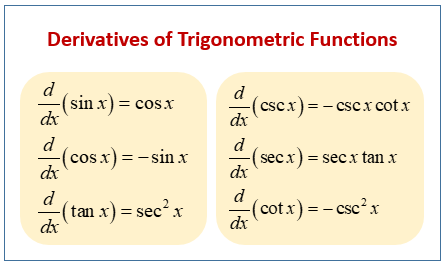
Ways to remember
the functions with c are always negative (cos=-sin, csc=-csccot, cot=-csc²)
sin loves cos, but cos doesn’t love sin (sin=cos, cos=-sin)
the tangents are always squared and love their partners more (sec², -csc²)
the sec and csc are self absorbed and always with their tangent partners (-csccot & sectan)
Derivatives of Exponents & Logarithms
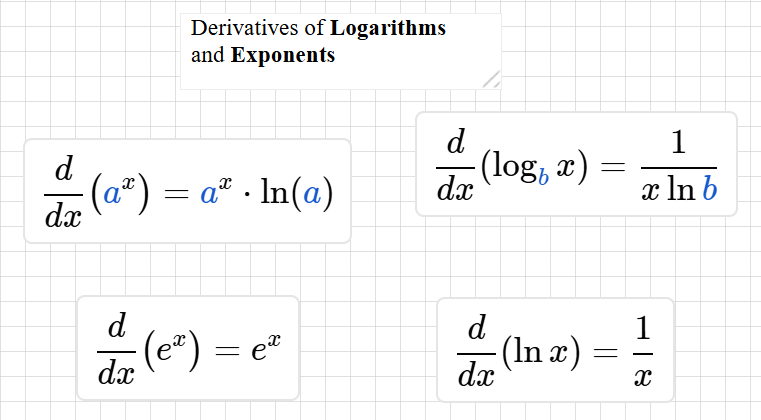
Unit 3 - Differentiation: Composite, Implicit, and Inverse Functions
The Chain Rule → \frac{d}{dx}f\left(g\left(x\right)\right)=f^{\prime}\left(g\left(x\right)\right)\cdot g^{\prime}\left(x\right)
The chain rule is used for functions inside of functions. It works like Russian nesting dolls the derivative of the outside function with all the normal dolls inside, then multiplied by the derivative of the next doll inside with the rest of the dolls inside
Example → \frac{d}{dx}\sec\left(x^3-2\right)=\left(\sec\left(x^3-2\right)\tan\left(x^3-2\right)\right)\left(3x^2\right)=3x^2\sec\left(x^3-2\right)\tan\left(x^3-2\right)
Implicit Differentiation
Sometimes, the functions aren’t always explicitly defined and we have both x and y → x² + y² = 1
Remember that taking the d/dx of x is just 1! Think of it like the chain rule → d/dx(f(x)) = f’(x) * 1. However, when we take the derivative of y with respect to x, that is dy/dx or y’.
\frac{d}{dx}\left(x\right)=\frac{dx}{dx}=1\\ \frac{d}{dx}\left(y\right)=\frac{dy}{dx}=y^{\prime}
This just means that whenever we are taking the derivative of y, we have to multiply it by dy/dx. A more complicated explanation is because of the chain rule, treating the singular function f(x) as a “f(g(x))” composite function, where the outside is “f( )” and inside is “x”
f’(x) * x’, but x’ (or dx/dx) is 1 so we normally leave it out, but with y → f^{\prime}\left(y\right)\cdot\left(\frac{dy}{dx}\text{ or } y^{\prime}\right)
This is why we have to multiply by dy/dx when taking the derivative of a non-x variable with respect to x
But you don’t really need to remember that, just remember that when taking the derivative of y, you have to multiply by dy/dx
Here is the steps to implicit differentiation
Differentiate both sides of the equation with respect to x
x^2+y^2=1\Rightarrow2x+2y\left(\frac{dy}{dx}\right)=0
Collect the terms with dy/dx on one side of the equation. Any time you have to take the derivative of y, multiply by dy/dx
2y\left(\frac{dy}{dx}\right)=-2x
Factor out dy/dx and/or solve for dy/dx
\frac{dy}{dx}=\frac{-2x}{2y}=-\frac{x}{y}
Tangent Lines
Let’s say we wanted to find the tangent line to the curve of x² - xy + y² = 7 at the point (-1, 2)
We’re already given the point, so we just need to find the derivative. For this one, we have -xy so we use product rule (xy’ + yx’)
2x-\left(\left(x\right)\left(\frac{dy}{dx}\right)+\left(y\right)\left(1\right)\right)+2y\left(\frac{dy}{dx}\right)=0
2x-x\frac{dy}{dx}-y+2y\frac{dy}{dx}=0\Rightarrow x\frac{dy}{dx}+2y\frac{dy}{dx}=-2x+y
\frac{dy}{dx}\left(-x+2y\right)=-2x+y\Rightarrow\frac{dy}{dx}=\frac{-2x+y}{-x+2y}
Now, we need to plug it into the derivative equation
\frac{dy}{dx}\vert_{\left(-1,2\right)}=\frac{-2\left(-1\right)+2}{-\left(-1\right)+2\left(2\right)}=\frac45
Now, we can use this and the point to find the tangent and normal lines
y-2=\frac45\left(x+1\right)
Higher Order Derivatives
When we do higher order derivatives with implicit differentiation, we solve for the first derivative like normal, but whenever we start solving for the second one, we substitute dy/dx with our first derivative. Example → what is the second derivative of 5 = x² - cos(y)
Find the first derivative → 0=2x+\sin\left(y\right)\left(\frac{dy}{dx}\right)\Rightarrow\frac{dy}{dx}=-\frac{2x}{\sin y}
Then we need to use the quotient rule to find the second derivative (substituting dy/dx with our first derivative) →\frac{d^2y}{dx^2}=\frac{\left(\sin y\right)\left(-2\right)-\left(-2x\right)\left(\cos\left(y\right)\frac{dy}{dx}\right)}{\sin^2y}\Rightarrow\frac{-2\sin\left(y\right)+2x\cos\left(y\right)\left(-\frac{2x}{\sin y}\right)}{\sin^2y}
Then, we can get rid of that numerator fraction by multiplying a sin(y) to the top and bottom → \frac{d^2y}{dx^2}=\frac{-2\sin^2y-4x^2\cos y}{\sin^3y}
Inverse Function Derivatives
An inverse function derivative is as so → \text{normally } f\left(x\right)=y\text{, }\text{and the inverse is } f^{-1}\left(y\right)=x\text{. So, the inverse derivative is }\frac{df^{-1}}{dx}=\left(f^{-1}\left(y\right)\right)^{\prime}=\frac{1}{f^{\prime}\left(x\right)}
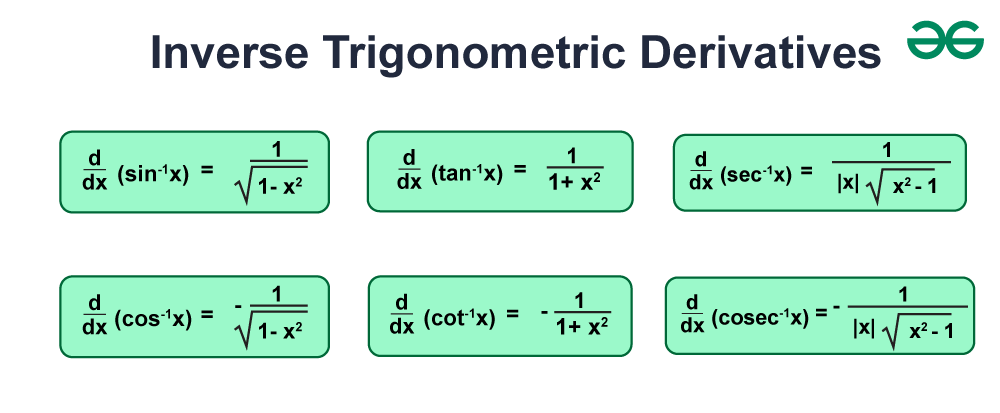
Ways to remember
Like our regular derivatives, the ones that start with c are always opposite to their partners
They are always 1 / something and always have an x²
You can think about it from easiest to hardest
Tangent and cotangent are easiest because it’s just 1 + x²
Sin and cos are next because they have sqrt and subtraction
Sec and csc are the most complicated and have | x |, sqrt, and flipped order, and subtraction
Unit 4 - Contextual Applications of Differentiation
Critical Points
To start, a critical point is any point where f’(x) = 0 or DNE. On the function f(x), they are all local extrema
In order for an x-value to be a critical point, that x-value must be in the domain of the function. So we need to look out for anything like
Dividing by 0
Taking the nth root of an even power
Taking the logarithm of 0 or a negative number
Example with function f(x) = x² / x - 1
Find domain of f(x) → x ≠ 1
Find the derivative → f^{\prime}\left(x\right)=\frac{2x\left(x-1\right)-x^2}{\left(x-1\right)^2}=\frac{2x^2-2x-x^2}{\left(x-1\right)^2}=\frac{x\left(x-2\right)}{\left(x-1\right)^2}
Now, because we have an instance of dividing by 0, we can solve for when f’(x) = 0 or DNE (In this case, we can set the numerator = 0 to find when f’ = 0 and the denominator = 0 to find when f’ DNE). When we find these, we need to check back to our domain and see if the points are included
x\left(x-2\right)=0\Longrightarrow x=0,2
\left(x-1\right)^2=0\Longrightarrow x=1\text{, not in domain}
So our critical points are x = 0, 2
Example with piecewise function → f(x) = \begin{cases}-x^{2}-2x+4,\space 0\leq x \leq 1\\-x^{2}+6x-4, \space 1\lt x\leq 4\end{cases}
Our domains would be [0, 1] and [1, 4], however because we have 1 on both, we need to check for continuity
\lim_{x\to1^{-}}-x^2-2x+4=1\\ \lim_{x\to1^{+}}x-^2+6x-4=1
Next, find when f’ = 0. Our f’ would consist of -2x-2 and -2x+6. So we just set them both to 0
-2x-2=0\Rightarrow x=-1, which is outside of the domain
-2x+6=0\Rightarrow x=3
Now to find when f’ does not exist. The only place where y’ might not exist is where those two functions meet (@ x = 1), so we check the one sided derivatives
\lim_{x\to1^{-}}-2x-2=-4\\ \lim_{x\to1^{+}}-2x+6=4, so, y’(1) DNE, meaning it is a critical point
Extreme Values
If f is continuous on a closed interval [a, b], then f has both a maximum and minimum value on the interval. These are either:
The values of f at the critical points in the open interval (a, b)
f(a) or f(b), the values of f at the endpoints
To find absolute extrema, we use the candidates test (basically a t-chart of the endpoints, and any critical points to find the highest and lowest values)
Example → f(x)=x^3-12x^2+21x\to\left\lbrack0,2\right\rbrack
First, find the derivative → f^{\prime}\left(x\right)=3x^2-24x+21
Next, find the critical points → 0=3x^2-24x+21\Rightarrow0=3\left(x-7\right)\left(x-1\right)\Rightarrow x=7,1\Rightarrow x=1
Now, for the candidates test, we have our endpoints, 0 and 2, and then our critical points. Here we can see that our absolute max is 10 @ x=1, and our abs min is 0 @ x = 0
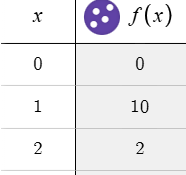
Intervals of Inc & Dec
When f is continuous and differentiable…
when f’ > 0, f is increasing
when f’ < 0, f is decreasing
The First Derivative Test determines if critical points are local mins, maxes, or neither
First find the critical points, then check for sign changes on f’
If f’ changes from + → -, then f has a maximum
If f’ changes from - → +, then f has a minimum
If f’ doesn’t change, then there is no local extreme
If there is endpoints, we need to consider the sign on f’ in the interval to the left/right of the endpoint and interpret whether f is increasing/decreasing approaching the endpoint to identify if it is a max or min
Example → f\left(x\right)=3x^4+4x^3-36x^2
Our domain is continuous, so we don’t have to worry about it
Find the derivative → f^{\prime}\left(x\right)=12x^3+12x^2-72x
Now, find the critical points → 0=12x\left(x+3\right)\left(x-2\right)\Rightarrow x=-3,0,2
Now that we have these points, we can perform the first derivative test. This is putting them on a number line and plugging in values in between the critical points to determine whether the sign is - or +
As we see here, our intervals of increasing would be \left(-3,0\right)\cup(2,\infty) and our intervals of decreasing would be \left(-\infty,-3\right)\cup\left(0,2\right)
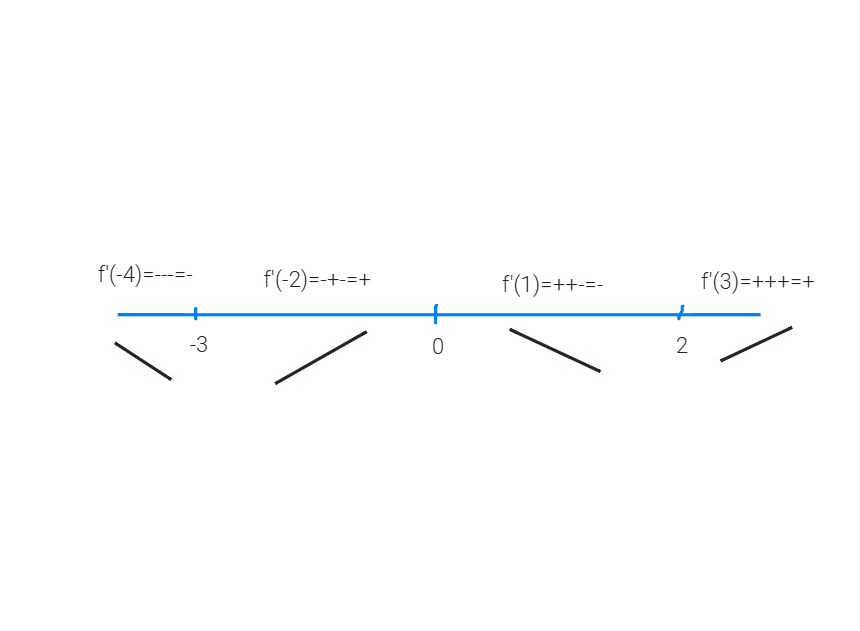
We can see that when both lines go down (switching from - → +), we have a local minimum. In this case it would be x = -3, 2
And when the lines both go up (switching from + → -), we have a local maximum. In this case it would be x = 0
Concavity and Inflection Points
Concavity is the curvature of the graph. For the concavity test, to find the signs of the second derivative, we use the second derivative instead of the first.
f is concave up when f’’ > 0
f is concave down when f’’ < 0
Points of inflection are where the concavity changes. In order to be a POI, it must be in the domain and change signs
Example → f=4x^3-21x^2+36x-20
Our domain is all real numbers, so no need to worry
We need to find our second derivative → \frac{d^2f}{dx^2}=24x-12
Now, setting it = 0, we get our potential points of inflection → 0=24x-12\Rightarrow x=\frac74
Now, like what we did before, we put this point on a number line and plug in values beside it to see whether it’s concave up/down and to see if the sign changes
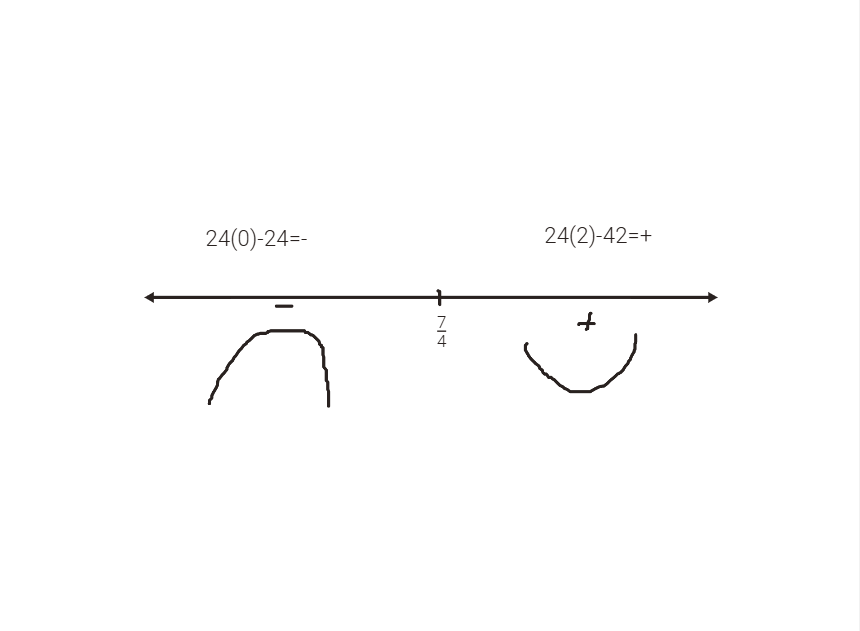
We can see that it’s concave down from (-infinity, 7/4) and concave up from (7/4, infinity)
Because the sign changes, there is an inflection point at x = 7/4
The Second Derivative Test is that by finding the sign of the second derivative at a critical point, we can determine whether the critical point is a maximum or a minimum
if f’ = 0 and f’’ < 0, then f has a local maximum
if f’ = 0 and f’’ > 0, then f' has a local minimum
Example → f\left(x\right)=x^3-12x-5;x=2,-2
Find second derivative → \frac{d^2f}{dx^2}=6x
Now, we plug in the critical points to see what the sign is → 6(2) = +, 6(-2) = -
This means that x = 2 is a local min and x = -2 is a local max
Mean Value Theorem
Remember that differentiability implies continuity!
The Mean Value Theorem for derivatives states that if f(x) is continuous at every point of the closed interval [a, b] and differentiable at every point of it’s interior (a, b), then there is at least one point c in (a, b) at which the derivative = average ROC of a & b or f^{\prime}\left(c\right)=\frac{f\left(a\right)-f\left(b\right)}{a-b}

Again, two conditions need to be met for this:
f(x) is continuous on [a, b] → to verify this, check any dividing by 0, sqrt of neg numbers, or logs of neg #s or 0
f’(x) is differentiable on (a, b) → to verify this, check the same as continuity but on the derivative
Example → y = x² on [0, 2]
First, check if y is continuous. There is no cases where we’d / 0, have sqrts of negative numbers, or logs of negative numbers, so it is continuous
Next, we need to find if y is differentiable
y’ = 2x, and there no place where it doesn’t exist, so y’ is differentiable
Now we need to find the value c so that y^{\prime}\left(c\right)=\frac{y\left(2\right)-y\left(0\right)}{2-0}
2c=\frac{2^2-0=4}{2-0=2}\Rightarrow2c=2\Rightarrow c=1
This point is in our domain, so that is our answer!
We also might be given a table of numbers like so and you’ll see questions like this:
h(x) is a differentiable function with the following values:
x | 1 | 4 | 8 | 9 |
h(x) | -4 | 0 | 5 | 7 |
Must there be a value c in 1 < c < 4 or (1, 4) such that h’(c) = 4/3? Justify your answer.
h(x) is differentiable so h(x) is continuous. MVT applies.
\frac{h\left(4\right)-h\left(1\right)}{4-1}=\frac{0-\left(-4\right)=4}{4-1=3}=\frac43
Yes, by MVT.
Is there a value x in 1 < x < 8, where h(x) = 1? (Be careful, because it’s asking about the actual function and not the derivative, this is IVT, not MVT)
h(x) is differentiable so h(x) is continuous. IVT applies.
\lim_{x\to1}h\left(x\right)=-4<1<5=\lim_{x\to8}h\left(x\right)
Yes, by IVT.
Using a Graph of f’ to Analyze Properties of f
We can look at a graph of f’(x) to analyze properties of f(x). here is a list of things on the derivative and what they mean on the actual function:
df/dx | f(x) |
positive | increasing |
negative | decreasing |
changes signs from + → - | maximum |
changes signs from - → + | minimum |
increasing | concave up |
decreasing | concave down |
changes from inc/dec → dec/inc | POI |
Here’s an example function
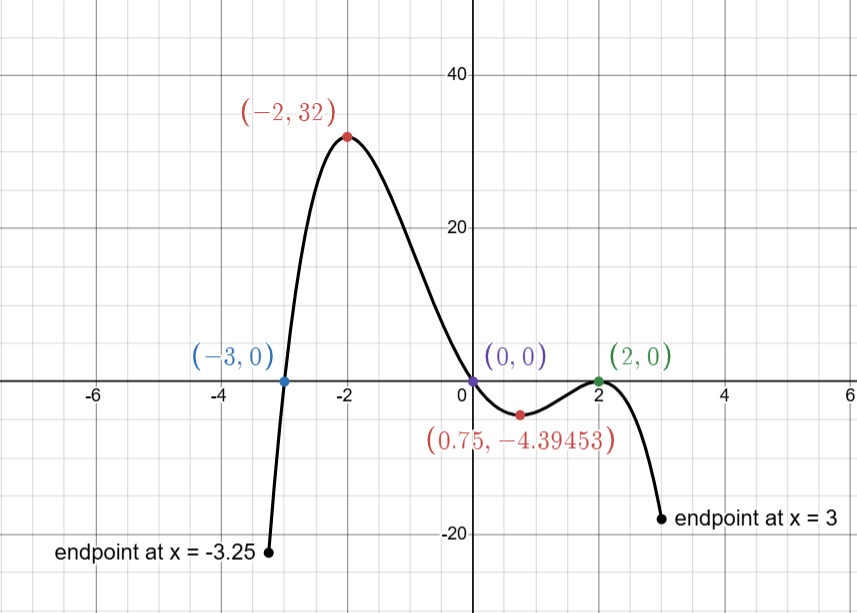
f(x) is increasing on (-3, 0), where df/dx is positive
f(x) is decreasing on (-∞, -3) U (0, ∞), where df/dx is negative
Maximums/Minimums
local maximums
x = 0, f’(x) changes from + → -
x = -3.25, left endpoint, f’(x) < 0 on (-3.25, -3)
It’s helpful to think about the sign chart. The number line would look like \ following -3.25. Because it’s to the left and approaching the right it is going up, it’s a local maximum
local minimums
x = -3, f’(x) changes from - → +
x=3, right endpoint, f’(x) < 0 on (0, 3)
It’s helpful to think about the sign chart. The line preceding 3 would look like \. Meaning that because it’s to the right and it’s going down, it would be a local minimum.
f(x) is concave up on (∞, -2) U (0.75, 2), where df/dx is increasing
f(x) is concave down on (-2, 0.75) U (2, ∞), where df/dx is decreasing
f(x) has a POIs at x = -2, 0.75, 2
Putting it all together → Derivative Analysis
We can also do this without a graph. We can now find critical information about f(x) from f’(x)
Example → f\left(x\right)=x^4-4x^3;\left\lbrack-2,4\right\rbrack
Derivative f’(x) = 4x³ - 12x²
Find critical points (f’ = 0 or DNE) → 0=4x^2\left(x-3\right)\Rightarrow x=3,0
Find the intervals where f(x) increasing/decreasing (First Derivative Test / where f’(x) > or < 0)
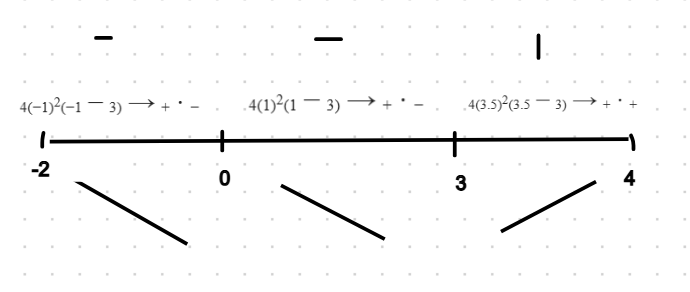
f(x) is inc → (3, 4)
f(x) is dec → (-2, 3)
Finding local extrema
local min @ x = 3, f’(x) changes from - → +
local max @ x = -2, left endpoint, f’ is - on (-2, 0)
local max @ x = 4, right endpoint, f’ is + on (3, 4)
Finding absolute extrema (candidates test)

abs min is -27 @ x = 3
abs max is 48 @ x = -2
Concavity & POI
2nd derivative → f’’(x) = 12x(x-2) → x = 0, 2

f(x) is concave up: (-2, 0) U (2, 4)
f(x) is concave down: (0, 2)
f(x) has POI @ x = 0, 2
Unit 5 - Analytical Applications of Differentiation
Velocity and Acceleration
In calculus, we can find an instantaneous rate of change.
Given the function s(t) that measures position over time, we know that the average velocity would be s(t2) - s(t1) / t2 - t1. Telling us how far it is traveled and how long the time was.
The derivatives of the position actually tell us different things
Function | What it tells us | Example of unit |
s(t) | Position | m |
s’(t) or v(t) | Velocity | m per sec |
s’’(t) or v’(t) or a’(t) | Acceleration | m per sec per sec |
Let’s try an example. In this a heavy rock is launched straight up and it’s position function is given by s(t) = 160t - 16t²
What are the velocity and acceleration functions of time?
v(t) = 160 - 36t ft/s
a(t) = -36 ft/s²
When does the rock change direction? How high did it go?
When the sign of velocity changes, direction changes. So we need to find when v(t) = 0 and changes signs. For finding height, we simply plug the time into the position function.
160 - 36t = 0 → t = 5 seconds
So, at s(5 seconds), the rocket is at 400 feet.
What is the total distance traveled between 0 < t < 7?
To find total distance, we just need to find the position at the start, end, and all the times the direction changes
First, at t = 0 seconds, s(0) = 0
Then, at t = 5 seconds (switches direction), s(5) = 400 feet
Then at t = 7 seconds, s(7) = -336 feet (going down)
Now, we add up the intervals → (0 + 400) + (400 + -336) = 464 feet
What is the speed at t = 8 seconds?
Speed is just | v(t) | so |v(8)| = 96 ft/s
Speeding Up vs Slowing Down
To find if something is speeding up or slowing down, we compare the signs of v(t) and a(t)
Speeding up → signs of v(t) and a(t) are the same
Slowing down → signs of v(t) and a(t) are opposite
Justification
(Speeding up/Slowing down) at t = time (units) because v(time) & v’(time) = a(time) (are both pos/neg / have different signs).
Velocity and Acceleration using Graphs
A velocity graph might look something like this →
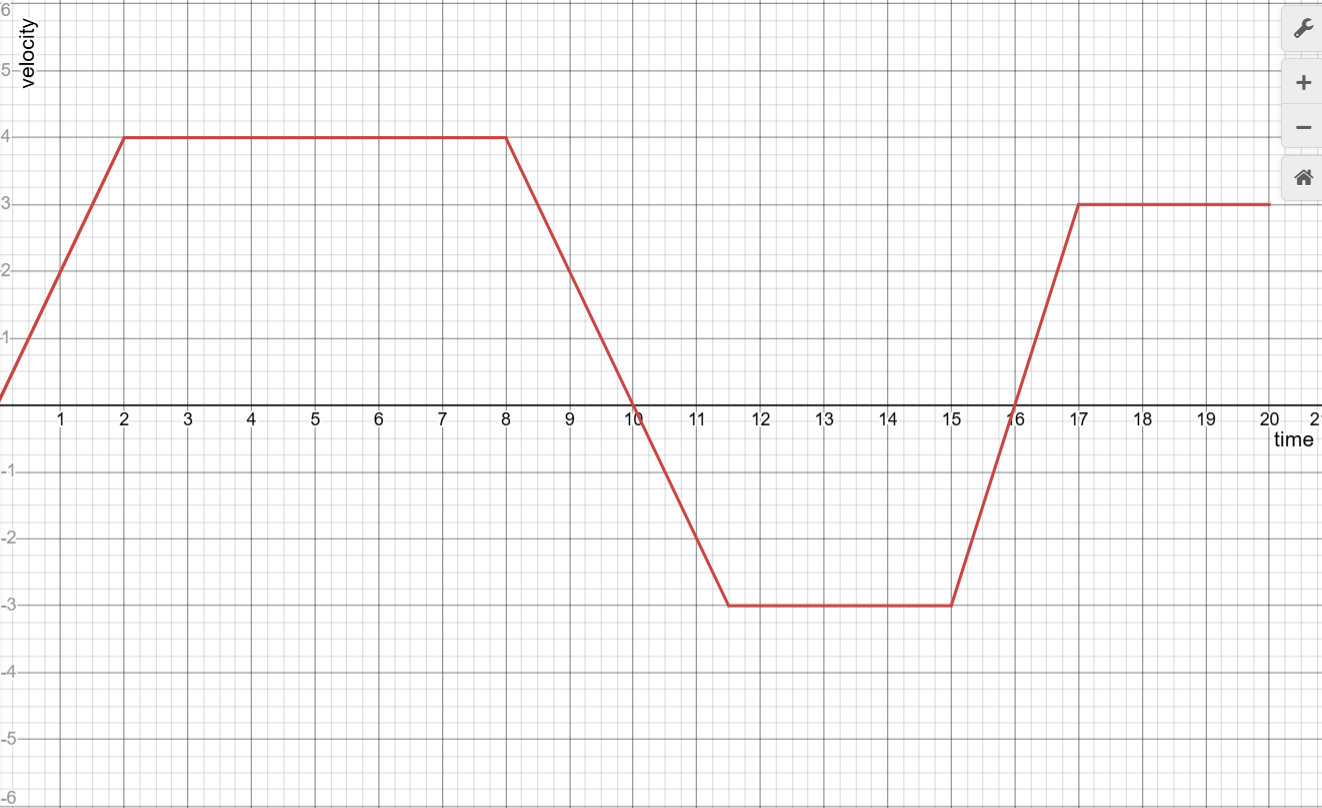
We can analyze this graph to figure out different questions. Let’s say this is the velocity of a ball floating in some random dimension from a time interval of [0, 20]
When is the ball moving forward and backwards?
It’s moving forward when v(t) > 0 so → [0, 10) U (16, 20] s
It’s moving backwards from (10, 16) s
When is the ball’s acceleration positive, negative, or zero?
For acceleration, it’s just the derivative of velocity, so we’re looking at the slope when it’s positive, negative, or zero
Positive acceleration → [0, 2) U (15, 17)
Negative acceleration → (8, 11.5)
Zero acceleration → [2, 8] U [11.5, 15] U [17, 20]
When is the ball at it’s greatest speed?
Remember, speed = |v(t)|. So → t = (2, 8)
When does the ball speed up and slow down?
Speeding up (velocity is pos & inc or neg & dec) → [0, 2) U (10, 11.5) U (16, 17)
Slowing down (velocity is pos & dec or neg & inc) → (8, 10) U (15, 16)
When does the ball change direction?
The ball changes direction when v(t) = 0 and changes signs
So t = 10, 16
What is the average acceleration between 10 < x < 13?
Average acceleration, like average velocity, isn’t using the actual acceleration function. Average acceleration uses the velocity function like so → v(t2) - v(t1) / t2 - t1
So → (0 - -3) / 10 - 13 = -1
When does the ball reach it’s highest point?
Think back to unit 4, where we found our maximums. Basically when v changes from + → -, we have a local maximum
So → t = 10
Rates of Change in Other Applied Contexts / Wording Derivatives
Here is a good explanation of a derivative in context. Make sure to give proper units, and do not phrase your description as an interval of time unless the problems calls for it.
For reference, V(t) gives rate that water fills a tank in liters per minute over t minutes modeled by the function V\left(t\right)=t^2
Find V(3) and interpret your answer.
V(3) = 9, which means at 3 minutes, the rate of which water is filling the tank is 9 liters per minute
Is the amount of water in the tank increasing or decreasing at t = 2.125 minutes?
Increasing and decreasing is just when the ROC is pos or neg. Because this function is a rate, we just need the sign of the function at t = 2.125 minutes
V(2.125) > 0, so the amount of water filling the tank is increasing.
Find V’(2.125) and interpret the value… is it increasing at an increasing rate, or increasing at a decreasing rate?
V’(t) = 2t = the rate of rate of change that water is filling the tank, measured in liters per minute²
Rate of rate of change > 0 = inc/dec @ increasing rate
Rate of rate of change < 0 = inc/dec @ decreasing rate
At t = 2.125 minutes, the rate at which water fills the tank is increasing at an increasing rate of 4.25 liters/min².
L’Hopital’s Rule
Remember indeterminate limits? 0/0 and infinity/infinity? We can use derivatives to solve them. L’Hopital’s rule basically states when\lim_{x\to a}{\frac{f(x)}{g(x)}}=\frac{0}{0}\text{ or }\frac{\infty}{\infty}\text{ then, }\lim_{x\to a}{\frac{f(x)}{g(x)}} = \lim_{x\to a}{\frac{f^{\prime}(x)}{g^{\prime}(x)}}
Let’s see an example → \lim_{x\to5}\frac{x^2-25}{x-5}=\frac00
AP doesn’t really like when you write 0/0 because it techincally doesn’t exist. Instead you would write two separate limit statements of the numerator and denominator and show they are both either zero or infinity
Next, we can take the derivative of the top and bottom → \lim_{x\to5}\frac{2x}{1}=2\left(5\right)=10
Another example → \lim_{x\to\infty}\frac{2x^2}{3\ln x}=\frac{\infty}{\infty}
\lim_{x\to\infty}\frac{4x}{\frac{3}{x}}\Rightarrow\lim_{x\to\infty}\frac{4x^2}{3}\Rightarrow\infty
With this example, once we simplify down the derivatives, we see that as x goes to infinity, the numerator gets bigger and bigger, meaning that we’ll have a bigger and bigger number, thus making it infinity